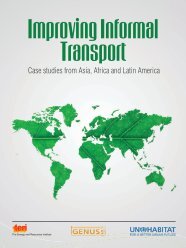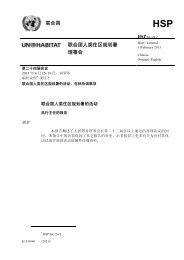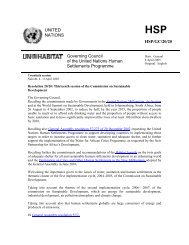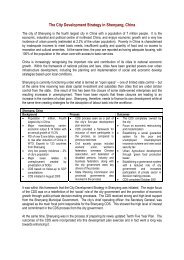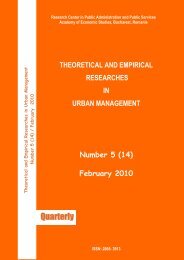Harmonious cities - UN-Habitat
Harmonious cities - UN-Habitat
Harmonious cities - UN-Habitat
You also want an ePaper? Increase the reach of your titles
YUMPU automatically turns print PDFs into web optimized ePapers that Google loves.
IN-FOCUS Water<br />
The impact of<br />
desalination in the<br />
Middle East and Asia<br />
It is a cruel irony that 71 percent of the Earth’s surface is covered by water, yet only a small<br />
percentage of this is drinkable. But, as Jonathan Andrews reveals, with developments in<br />
desalination technology, what was once a prohibitively expensive process restricted only to<br />
oil-rich nations, has become an affordable option for many <strong>cities</strong>.<br />
The International Desalination Association<br />
(IDA) states that there<br />
are now 13,080 desalination plants<br />
in operation around the world in almost 100<br />
countries. This may seem a sizeable amount,<br />
yet the plants only produce 0.5 percent of<br />
global water use. Almost half of these plants<br />
are found in the Middle East, where energy is<br />
cheap and water scarce. But many other <strong>cities</strong><br />
in the US, Australia, Spain, India, Africa and<br />
China are now turning to the technology to<br />
meet growing demands.<br />
Historically, there has always been a human<br />
interest or dream of turning the abundance<br />
of salt water into drinkable water. The<br />
realisation of this began during World War<br />
II, when military establishments operating in<br />
arid areas needed a way to supply their troops<br />
with potable water and developed very basic<br />
models.<br />
The movement took a giant step forwards<br />
in the 1950s and 1960s when the US government,<br />
at the behest of President John<br />
Kennedy, established the Office of Saline<br />
Water and then later the Office of Water Research<br />
and Technology in a major effort to<br />
26<br />
u r b a n<br />
WORLD<br />
November 2008<br />
Lisa Henthorne, President of the IDA<br />
Photo © idA<br />
develop the industry. At the same time the<br />
Middle East was discovering the advantages<br />
of its vast oil fields and the potential of desalination.<br />
“Previously, the high costs associated with<br />
desalination hindered interest in abundantly<br />
available seawater as a potential water source.”<br />
– Karen Dobson, Dow Water Solutions<br />
“Desalination took off in the Middle East,<br />
due to a complete lack of water,” explains Lisa<br />
Henthorne, President of the IDA. “When it<br />
realised the potential of its huge fossil fuel<br />
resources, thermal desalination plants were<br />
built alongside power plants.”<br />
This simple concept involved using the heat<br />
from the power plants to boil water, collect<br />
the steam and then condense it to make pure<br />
water. “It was relatively efficient, because it<br />
used the waste heat to create the water,” adds<br />
Henthorne.<br />
Advancements in membrane technology,<br />
that is necessary in the reverse osmosis process<br />
involved in some desalination plants, have<br />
increased dramatically in the past 30 years.<br />
Reduced energy use, lower overall treatment<br />
costs, and raised water quality all make it an<br />
attractive alternative.<br />
“They have broader applications to countries<br />
that don’t have the resources of fossil<br />
fuel like the Middle East; they use less energy<br />
and don’t need to be co-generated next to<br />
power plants,” explains Henthorne.<br />
Perth, on the drought-ridden western coast<br />
of Australia, is one city that has not traditionally<br />
been a market for desalination, but has<br />
recently built the largest plant in the southern<br />
hemisphere.<br />
Dow Water Solutions, a desalination company<br />
whose reverse osmosis technology is at<br />
the heart of the Perth plant, believes its appeal<br />
is increasing.<br />
“Previously, the high costs associated<br />
with desalination hindered interest in abundantly<br />
available seawater as a potential water<br />
source,” says Karen Dobson from Dow Water<br />
Solutions. “The successful operation of the<br />
Perth plant is further proof that we have in




